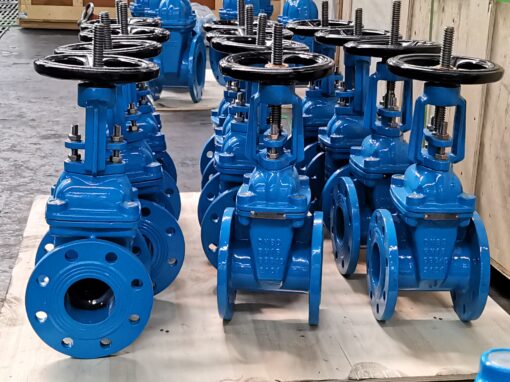How does the resilient seat contribute to the valve’s ability to maintain a tight seal over time?
The resilient seat in a non-rising stem resilient seated gate valve plays a crucial role in maintaining a tight seal over time by offering the following contributions:
- Flexibility and Resilience: Resilient seats are typically made from materials like EPDM, NBR, or other elastomers. These materials are known for their flexibility and resilience, which allows the seat to deform and adapt to the shape of the gate and the valve body, ensuring a tight seal even when there are minor imperfections or dimensional variations in the gate or body.
- Resistance to Wear and Tear: Resilient seat materials are highly resistant to wear, abrasion, and corrosion. This resistance helps the seat maintain its sealing properties and prevent leakage, even when exposed to harsh or abrasive fluids.
- Sealing under Low Pressure: Resilient seats can provide effective sealing at low pressure differentials. This makes them well-suited for applications where the valve may be used to control or isolate the flow of liquids or gases under varying pressure conditions.
- Longevity: Resilient seats have a long service life due to their durability. They can maintain their sealing capabilities over an extended period, reducing the need for frequent maintenance and replacement.
- Backflow Prevention: Resilient seats provide effective backflow prevention by sealing tightly in the closed position. They prevent the reverse flow of fluids and maintain a secure seal, enhancing safety and system integrity.
- Thermal and Chemical Resistance: Resilient seat materials are often selected for their resistance to a wide range of temperatures and chemicals. This makes them suitable for use in diverse industrial applications where the valve may come into contact with aggressive fluids or undergo temperature fluctuations.
- Easy Replacement: If the resilient seat does wear out or become damaged over time, it can be relatively easy to replace without the need for extensive valve disassembly. This helps maintain the overall efficiency of the valve and reduces downtime during maintenance.
- Lower Operating Torque: The flexibility of the resilient seat reduces the friction between the gate and the seat, resulting in lower operating torque. non rising stem resilient seated gate valve This contributes to smoother valve operation and reduced wear on the valve components.
- Reduced Leakage: The combination of the flexible resilient seat and the gate design in a non-rising stem gate valve minimizes the potential for leakage, which is essential in applications where tight shutoff is critical.
In summary, the resilient seat in a non-rising stem resilient seated gate valve maintains a tight seal over time through its ability to adapt to gate and body imperfections, resist wear and tear, seal effectively at low pressure differentials, and withstand various environmental and chemical conditions. This contributes to the valve’s long-term reliability and leak-free performance.
How does the non-rising stem design make it easier to install and maintain the valve in a pipeline?
The non-rising stem design in a valve, such as a non-rising stem resilient seated gate valve, makes it easier to install and maintain in a pipeline for several reasons:
- Vertical Space Savings: Non-rising stem valves are more space-efficient because the stem does not extend vertically when the valve is operated. This is particularly advantageous in installations with limited vertical clearance.
- Ease of Installation: The absence of a rising stem simplifies the installation process. There is no need to account for the vertical space required for stem movement, making it easier to position the valve within the pipeline.
- Reduced Maintenance Space: Non-rising stem valves are often easier to access and maintain. With no need to disassemble or remove the valve from the pipeline for stem maintenance, routine inspections and servicing can be performed more conveniently.
- Less Obstructive in Pits and Vaults: In applications where valves are installed in underground pits or vaults, the non-rising stem design makes it less obtrusive and easier to access for maintenance. This can save time and effort during repair or inspection tasks.
- Lower Maintenance Costs: The design minimizes the need for stem maintenance, lubrication, or stem packing replacement. This can result in cost savings by reducing labor and material expenses associated with stem maintenance.
- Reduced Risk of Contamination: Rising stems can be prone to contaminants, such as dirt and debris, entering the stem housing. Non-rising stems are generally better at preventing contamination, enhancing the reliability and longevity of the valve.
- Simplified Bonnet and Gland Nut Design: The non-rising stem design often uses a simplified bonnet and gland nut, which are easier to operate and maintain. This can further reduce the maintenance effort and cost associated with these components.
- Enhanced Safety: Non-rising stem valves can be safer to operate, as there is no risk of injury due to the exposed moving stem. This can reduce the likelihood of accidents during valve operation and maintenance.
- Long-Term Durability: The reduced exposure of the stem to external elements, such as weather and environmental factors, can contribute to the long-term durability of the valve and its components.
- Seal Integrity: Non-rising stem designs typically have excellent seal integrity, ensuring that the valve remains leak-tight over time. This minimizes the need for frequent adjustments or maintenance to address stem-related leaks.
In summary, the non-rising stem design simplifies the installation and maintenance of valves in pipelines by saving vertical space, reducing maintenance costs, enhancing access, and improving safety. These advantages make non-rising stem valves a practical choice for various pipeline applications, particularly when space constraints or accessibility are concerns.
